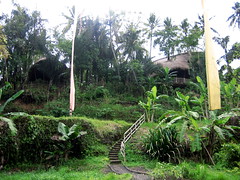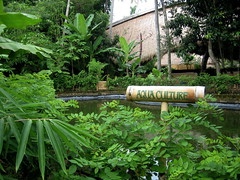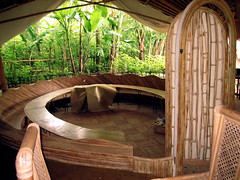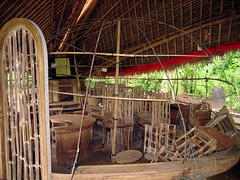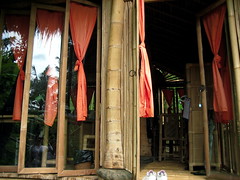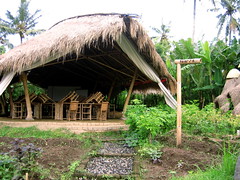Just over a week ago, I had the pleasure of visiting Green School. Green School is a new educational venture in Bali, Indonesia, and is the vision of John and Cynthia Hardy (yes, that’s John Hardy of John Hardy designs). If you don’t know anything about Green School, know this: it is a school with an ambitious and idealistic mission and vision. It is really worth checking out their website if you’ve not done so before, as my post will not go into background, history, or other details about the school. If nothing else, watch this 3 minute video, which succinctly shows the vision behind the school:
I have written about the Green School on this blog before, but back then I was writing about a desire to visit and a missed opportunity. Shortly after that post, then-director Brad Choyt sent me a kind e-mail inviting me to visit the next time I was in Bali. Green School also graciously posted a link to my blog on their website, an act I sincerely appreciate. I stayed in touch with Mr. Choyt since then, and so when I knew I was going to be in Bali for a yoga retreat, I sent him an e-mail. He responded immediately and plans were made with the Admissions Manager to arrange my visit.
January 9th arrived and I made my way out to Green School with a new friend* from my yoga retreat. Ami, the Admissions Manager I had arranged the appointment with, met us at the parking lot. She was friendly, inviting, knowledgeable, and accommodating. Our tour began on the west side of the campus and ended on the east side – the campus is divided into east and west, separated by the gorgeous Ayung river. It’s a beautiful eco-friendly campus filled with unique and sustainable ideas for living: compost toilets, hydropower, permaculture, you get the idea.
I’m not going to write about what the campus looks like, what they’re doing there, or why they’re doing it: you can find out all of those things by visiting their website and doing some quick Google searches. But I will highlight some of my biggest highlights, insights, and concerns. It was a pleasant, educational, and insightful visit. Keep in mind as you read that I approached this visit not only from a holistic educational perspective, but also from an experiential teaching-learning perspective; I frequently asked myself, “How would I teach if I worked here?” Please also keep in mind that this post is not intended to “report” on Green School’s progress in any way. My purpose is to share what I saw and experienced in my first visit (hopefully of many) to Green School, and to share what were for me some of the highlights, insights, and some of the Big Questions I have had since returning to Hanoi.
Sustainable Structures, Sustainable Living and Learning
One of the first questions I asked Ami was about the unusual structures we had seen upon driving into campus – what looked like giant bamboo yurts. She informed me that they were indeed bamboo yurts, and were staff and faculty housing. Whoa! Now that is something I had not seen before. I really wanted to go back and take photos, but couldn’t – staff were on vacation and had not been informed that a visitor would be around taking photos, so it was a no-go. However, upon returning to Hanoi, I have discovered that theflattestcat has photos of these yurts posted both on an old blog and his Flickr photostream, so go check ‘em out. (They’re not licensed under CC, so I can’t reproduce them here.)
Green School classrooms are… well, they’re not classrooms in the traditional sense. However, they’re not classrooms in the metaphorical The-World-Is-Your-Classroom sense, either. They are somewhere in between. Made of bamboo and hardened mud, they are essentially covered open-air structures, each with a cooling space. They have fans, blackboards (yes), desks, shelves, cubby spaces for storage, and more. Green School also has wireless all over campus including classrooms.
While all of this – housing, classrooms, offices made of bamboo and mud — looks really cool and I love the idea of a structure made from sustainable materials, it raises practical and logistical issues:
- Where does one keep resources? From what I could see, the school is not yet well-resourced (they don’t yet have a library, and Ami told me that currently each teacher keeps a classroom library). Granted this is their first year in operation, so I suppose this is to be expected. But I’m wondering, if teachers are creating or bringing in resources – books, instruments, costumes, posters, puppets – where on earth do they store them so that they do not get destroyed by the elements? Obviously, keeping them in your classroom isn’t the best idea, and if you’re living in a yurt… It just seems to me that no matter what, your stuff is going to be a victim of earth, air, and water. Perhaps this is what Green School wants – for teachers to think completely differently about the way they use resources. And, this is great. I just wonder how that works, particularly for the upper grades (Green School currently only goes up to Year/Grade 8). Yet, according to the Year 7/8 classroom blog, they are studying The Giver and using novel study packages. So where are they keeping all these books so that they don’t get eaten my mould? How will they stop those study package pages from turning yellow? And a bigger question – why are they using study packages? But wait – I’ll get to that question later.
- Where are things like music, drama, and P.E. taught? Are they entirely outdoors as well? I presume that given the philosophy of Green School, such activities are integrated into regular classroom activities. But even when done this way, these activities require special spaces, and I did not see much in the way of compensation for this while at Green School, other than the soccer pitch and the Mepantigan Center.
- How economically practical are these structures? First, a disclaimer: I know very little about the economics of sustainable building materials and energy costs, so what I’m about to say might just sound — well, ridiculous. I’m hoping someone will leave a comment about this particular concern to educate me a bit. Ami told us that the hydropower costs $15,000USD per classroom. Admittedly, I realize now I made unclear notes and I know absolutely nothing about “regular” energy costs in a school; I did not ask her if that was per year, per month, or per week. Let’s assume that it’s per year – is that a feasible amount to spend on energy per year? Honestly, I have no idea. It sounds like a lot to me, but I suppose that is the drawback of using sustainable, renewable, and eco-friendly resources. This is really not my area of expertise; call me curious with a healthy dose of skeptical. Ami also told us that the upkeep of the bamboo structures is really expensive – they must be cleaned regularly due to the exposure to the elements.
- For how long will classes be combined? Currently there are two grade levels per class (Year 1-2, 3-4, etc.). I suspect this is simply because of low student numbers at the moment (current enrolment is at 103 from PK-8). But is it feasible for this to continue? When curriculum is articulated clearly, teaching mixed grades can be a challenge. Not insurmountable, but certainly a challenge. I have mixed feelings about this issue.
Technology and the 21st Century
With a wireless campus, I would expect to see technology everywhere. Not so at Green School. The only technology I saw was in the business and administration offices. When I asked about this, I was told that students are encouraged to bring their own laptops. “Great!” I thought, initially. But now, having thought about it more, I wonder about how effective this system actually is. It reminds me of a post Julie Lindsay wrote back in October, asking what model schools use when implementing 1:1 programs. This option, “a student-purchased environment” only truly works when all students’ families can afford to purchase the technology. At Green School, I wonder about 20% of the student population — Balinese students who are there on scholarships. Who pays for their laptops?
I also did not see any projector screens or speakers in any of the classrooms I visited. I was told that these are available when teachers need them. It is worth considering that technology in general was likely not out in the open in classrooms because school was currently on break, and leaving it out obviously exposes it to the elements. However, it did make me think about use of technology at Green School and allowed me to reflect upon how I use technology for learning. Considering I use both audio and video in my current classroom on a daily basis, I had difficulty imagining how I would cope without regular access to them. Teaching and learning would change dramatically, and I’m not sure it would be for the better. Even when not all my students have laptops, these two pieces of equipment, when attached to my laptop, enable learning for all students, via visual stimuli such as video, text, and other images.
The issue of how to combine sustainable living and technology in a learning environment is perhaps the biggest challenge to any school. Green School looks like it is committed to tackle this challenge, but I’m not sure it has happened upon any real solutions yet.
Leadership
I must admit I suffer from a bit of Red Flag Syndrome in this area. It was strange, to say the least, that the director I had been in contact with until a few weeks before my arrival, Brad Choyt, was not the director I met when I arrived at Green School. Indeed, I was told almost immediately upon arriving that Brad Choyt was no longer director and that he “finished his contract” in December 2008. This surprised for a couple of reasons:
- I subscribe to Green School’s newsletters, and there had been no mention whatsoever of a leadership change. Upon my return to Hanoi, however, the most recent newsletter (January 16th) was signed by the new director and contained a link to CNN’s feature on Green School. (A very cool video – go watch it; I can’t embed it here for copyright reasons.)
- Green School’s website also does not indicate any kind of leadership change announcement. At least, I couldn’t find one – perhaps it’s there embedded somewhere and I missed it.
Of course, any time an organization has a quick and unannounced leadership change, there is cause for eyebrows to be raised. This is no exception. I did, however, have the pleasure of meeting the new director, Ronald Stones. We chatted briefly – maybe 10 minutes – about his new position at Green School and he seemed clearly excited, even if somewhat overwhelmed, by the unique challenges ahead of him. He is a warm gentleman, clearly knowledgeable in the area of international education and has the background to prove it. Of course, the international teaching community is small and we quickly discovered that we have mutual acquaintances and colleagues.
My first impressions of Mr. Stones were very positive, though our conversation did raise another issue which for me is, as my grandmother would say, a real doozy.
Curriculum
This is perhaps where my greatest concerns lie. While sustainability and technology issues are concrete and ultimately solvable with creative thinking, the issue of curriculum (and its blood-brother, assessment) is a monster much more dense.
Being from a primarily IB World School background (UNIS is the third IB World School I have taught at in the past 8 years), and in particular an MYP specialist, one of the first questions I had for Mr. Stones was about curriculum. I have spent much time on Green School’s website, since my last post about them and I love the philosophy statements written on their curriculum page; they reference both Waldorf-Steiner and IB curricula philosophies. Being curious, in September 2008 I asked the MYP Regional Manager for the IB Asia-Pacific if Green School was going to implement IB curriculum. He told me then that they had not, as of yet, contacted the IBO at all. I found this rather strange; applying for IB authorization, regardless of which programme, is a lengthy and time-consuming formal process. Green School’s website states their curriculum is “within an IB framework,” yet they have not formally initiated the authorization process. This is a bold move, in my opinion, to formally state this but to not initiate it.
I told Mr. Stones my background, and that I was very curious about Green School’s curriculum. His initial response indicated curriculum was an area of interest and concern for him, and it caused my Red Flag Syndrome to surge again slightly. To his credit, Mr. Stones clarified and went on to say that at the moment curriculum was a challenge for the school. (Note that I think this is probably to be expected, considering they are such a new school and only in their first year.) He explained that they needed something more concrete in place, as at present there was not enough of a continuum. I appreciated his honesty greatly, and I have to give Mr. Stones much gratitude for being brave enough to talk with me about curriculum, considering he had only been on the job for little more than three weeks. He said the current curriculum seems to come from a variety of sources and that one of the schools great tasks was to ensure that the curriculum was clearly articulated. He lauded the school’s strength of having faculty from a wide range of traditions, backgrounds, and experiences, but indicated that it would be necessary for everyone to be on the same page in order to move forward.
Wow, what a task! And I must say, that is one challenge I am glad I am not part of. To come into a school half-way through its first year and try to pull in all the curriculum threads from various teachers who have already been teaching there – to me, herding cats sounds easier. I have already worked at one international school where MYP was being implemented after having tossed out the British National Curriculum, and it was not pretty. When it comes to curriculum philosophy my belief is, and my experience indicates, that everyone has to be on the same page before any teaching begins.
Too many schools, educators, administrators, and parents take educational philosophy for granted. They assume that others believe what they believe, and go on their merry way. The difficulty arises when a stakeholder says, in Jerry Maguire style, “Show me the money” and you have to find evidence of that philosophy in concrete daily learning activities. One of the most useful professional appraisals I experienced was in my first international school, when my principal asked me how my teaching philosophy manifested itself in my classroom – she wanted me to show her something concrete and tangible as evidence that I was walking the talk. That exercise has stayed with me in the seven years since, and I think daily about how my classroom and my students’ learning experiences concretely reflect my philosophy. I must be the change, as Gandhi says. It’s no surprise that that principal who challenged me is now the Director of the IBAP – she required me to rise to meet the very expectations I was demanding of my students.
Green School has plenty of ideal, grounded, progressive philosophy ideas about education in this century and beyond. It seems to have the right idea. But where is the curriculum? What is the actual documentation that will indicate what students will learn and how? And where is it manifested within classrooms? I suspect Mr. Stones and his faculty will be trying to find that delicate balance between idealism and structure. At some point, someone will demand, if they haven’t already, “Show me the money.” Mr. Stones seems to have the experience and the know-how to move Green School in the right direction in this respect, though I admit I do not know his background in curriculum matters and those of philosophy. I will be watching eagerly to see how it all works out.
Green, But Growing
Green School is a continual work in progress. Such is evident when visiting the campus – construction is everywhere, and Ami commented several times how often the physical campus is changing. Last week there wasn’t a gymnasium; this week there is. Current construction continues on the Heart of the School, and there is a general sense when walking around their idyllic campus that things will continue to evolve. Change is good, and Green School gets that.
While currently Green School looks, well… a little green in the educational world, I do sense a firm future for them. At some point they will stop being novices and will have a stronger foundation in their educational niche. While revolutionary and cutting-edge now – perhaps even to the point of awkward — it is a place I envision becoming quite a beacon in the realm of international education. I daresay it’s a place I might be intrigued to work at in a few years’ time. They are at the forefront of a new movement and as such are one to keep an eye on. For now, though, I will watch curiously from the sidelines and see how the lotus unfolds.
*Special thanks to Emily for use of her camera during our visit!
